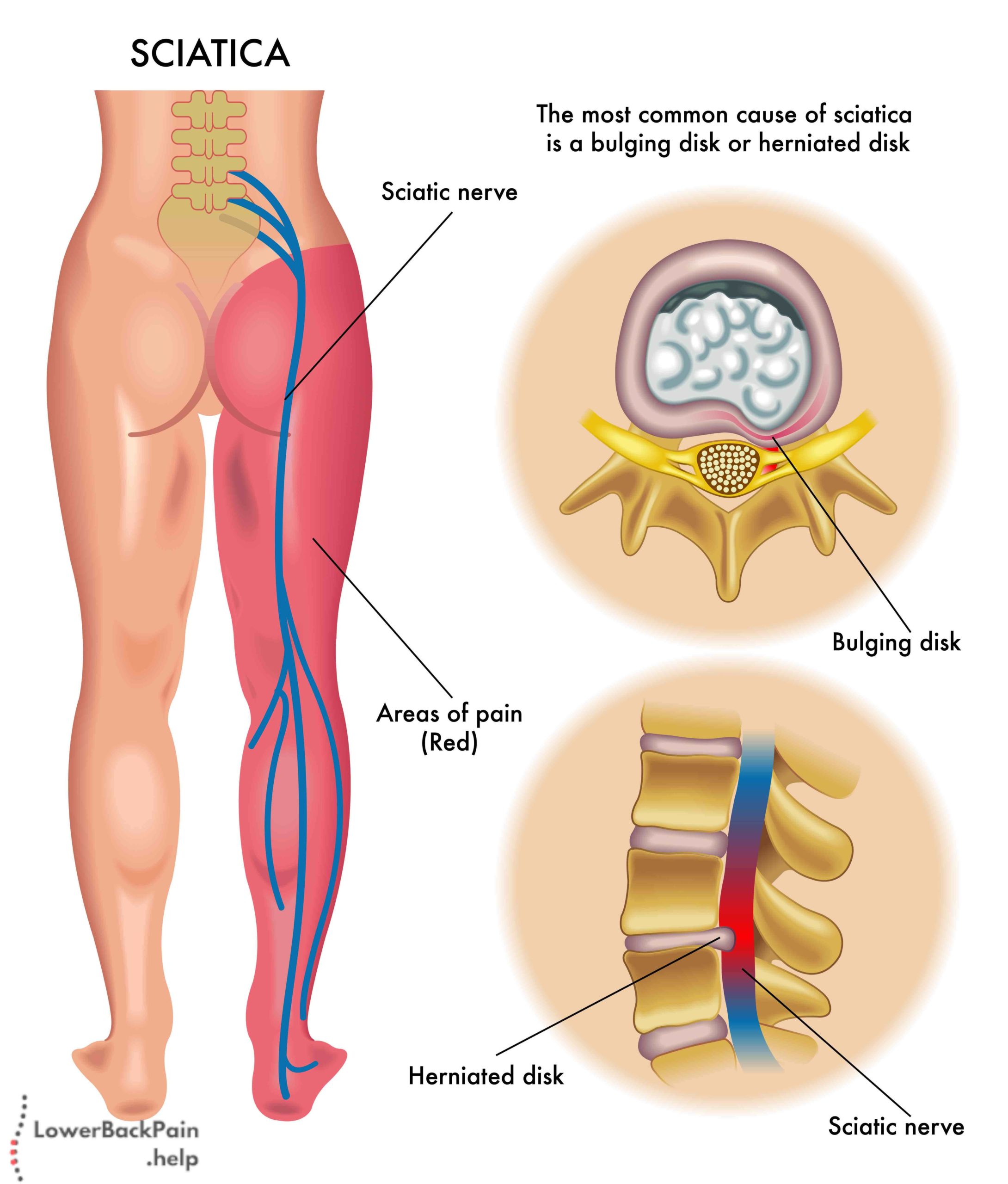Table of Contents
There are many different types of back and nerve pain, and some nerve pain is relatively minor while other types are more serious.
Because back pain is so ubiquitous and it’s something that almost everyone experiences in one form or another, it can be difficult to diagnose exactly what kind of pain you’re experiencing.
Sciatica, or sciatic nerve pain, is a kind of pain that originates in the sciatic nerve.
But what does that mean exactly? What is sciatica and how can you be sure you suffer from it?

The sciatic nerve is one that begins at the very lowest point of your back and continues down through your buttocks and legs.
So sciatic pain is any kind of pain or discomfort that branches down the sciatic nerve.
This makes it relatively easy to identify compared to other types of back pain.
How Sciatica Happens
The reasons for someone developing sciatic pain can vary drastically.
But a common cause for sciatica begins with a herniated disc in the lower or lumbar spine. The vertebrae that make up your spine are separated and normally protected by flexible but firm discs of connective tissue.
If one of these discs eventually wears down, the soft center can push out from the hard outer ring and cause pain or discomfort. This herniation can be caused by injury or from improper posture or many years of regular movements.
If a disc does herniate, pressure may increase on the nerves surrounding the original disc area. The sciatic nerve can easily be inflamed or irritated from a condition like this. As the longest nerve in your body, it’s uniquely situated to be affected by a variety of medical conditions that can cause discomfort and pain over time.
We have a section dedicated exclusively to herniated discs. See here.

Other potential causes include burn spurs (where bones meet each other in your joints) and spinal stenosis, which means the narrowing of your spine.
Either of these can put pressure on the sciatic nerve in the lower region of your back.
How to Tell if You Have Sciatica
Sciatica has several distinct signs that can help you with diagnosing the condition.
For starters, any pain that radiates from the lower back into your buttocks or the sides of your legs may be a sign of sciatica.
If you look at the picture above you see the red area.
Everything that is red could be a potential area of pain caused by sciatica. In the example above it is shown on the right leg, but of course, this applies to the left side as well.
The pain ranges from relatively mild, like a general ache from fatigue, to very serious and sharp or severe pain.
Unfortunately with sciatica, severe pain is fairly common.
Further potential symptoms include numbness in the affected regions, as well as tingling or a weakness in the legs or feet. Because the sciatic nerve goes all the way from your lower back down to your foot, the entire region may be affected in the most drastic cases.
So if you experience pain in your lower back as well as in one of your legs (or your buttocks) chances are you are suffering from sciatica.
Who Is At Risk for Sciatica?
Many people may be at risk for this condition, although there are some commonalities between most patients.
The majority of people who get sciatica are between 30 and 50 years old and are at least slightly overweight.
The reason is simple: because extra weight puts more pressure on the spine, which then increases the chances of a herniated disc.
Also, diabetes or other chronic conditions can also cause nerve damage over time.
If this condition or others directly affects the sciatic nerve, this can lead to sciatica.
As you can imagine manual labor jobs can damage the discs of your back and lead to sciatic damage.
Examples of these jobs include construction workers, loggers, or other workers who spend lots of time lifting things up and down and working their lower back.
That does not mean that jobs that are relatively sedentary can’t lead to sciatic damage, however.
Sitting for long periods of time is not good for the human spine and may lead to a herniated disc over time.
If you have a 9-5 job in an office we have put together some useful pieces of information on how to get through your day with lower back pain. (LINK)
What Can You Do for Treatment?
Fortunately, there are many ways to treat sciatica.
In fact, most victims of this condition eventually recover without surgery after a few weeks of care and attention.
In the interim, before you actually receive a diagnosis, over-the-counter painkillers such as ibuprofen are usually enough to help deal with the majority of nerve pain.
These are only short-term solutions, however.
If you think you have sciatica, you should always talk to your doctor and try to get a full diagnosis. They’ll be able to more accurately identify whether the back pain you are experiencing is because of this condition in particular or something else.
Once you have a diagnosis, doctors may recommend several treatments before committing to any kind of surgery (which should always be the last option).
One of the most common types of treatments is cold packs, which are placed on the lower back to reduce swelling and irritation.
They may also assign you to a chiropractor or a back injury expert to help you learn how to stand correctly or perform particular stretches to relieve you of pain and improve the location of a herniated disc.
It’s critically important that you keep moving if you believe you have sciatica.
Sitting still will only keep the nerve irritated and may even exacerbate your pain.
Keeping yourself in motion will reduce inflammation over time.
Eventually, if your sciatic pain doesn’t decrease, your doctor may prescribe additional medications like muscle relaxants and anti-inflammatories. They may also prescribe various types of physical therapy or acupuncture.
And what about surgery, you ask?
Well…
You’ll only need to consider surgery if your pain lasts for more than a few months.
In this case, reparative damage may be necessary to fully heal your sciatic nerve and take care of the condition permanently. This is a rare instance, however.
Tell your doctor immediately if you have extreme pain and are unable to function normally because of discomfort.
Additionally, the location of the sciatic nerve may affect your bladder or bowel functions; let your doctor know if these systems begin to malfunction for your case, as it’s a sign of serious sciatica.
Don’t be shy. Your doctor is a professional and there is no reason not to mention it.
Conclusion
Sciatica can be a potentially painful and frustrating condition to deal with.
But the good news is that most sciatica incidents are relatively minor and can be treated quickly and effectively.
Sciatica is unlikely to become chronic in most cases.
If you can identify that you have sciatica early, chances are good that you’ll be able to repair the damage or relieve yourself of pain fairly quickly.
